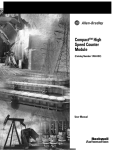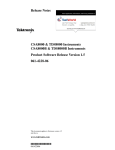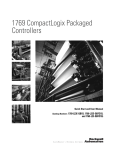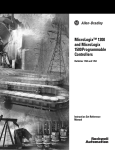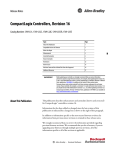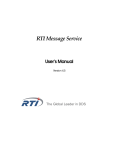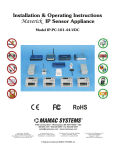Download Output Control
Transcript
Module Operation 2-23 Cyclic Method Since the update time is programmable, there is more flexibility in choosing the correct fit when using the Cyclic Method. Error estimates are shown below for a variety of update times. Table 2.9 Maximum Cyclic Rate Errors CyclicRate Update Time x Scalar Frequency 100 Hz 1 kHz 10 kHz 100 kHz 1 MHz 1 n/a n/a 20.02% 2.011% 0.210% 10 n/a 20.11% 2.020% 0.210% 0.030% 100 20.01% 2.110% 0.220% 0.031% 0.012% 1000 3.010% 0.310% 0.040% 0.013% 0.010% 10,000 1.210% 0.130% 0.022% 0.011% 0.010% See also: Rate Accuracy graph on page A-3. Output Control All 16 outputs can be controlled by any of the 4 counters or by the user’s control program, via the output mask function. Output states are determined by count, rate, ranges, mask configuration data, overcurrent status, and safe state settings and conditions. The 16 outputs are made up of 4 real (physical) outputs and 12 virtual outputs. The status of the real and virtual outputs is available to the user program. The real outputs are electronically protected from overloads. IMPORTANT To turn outputs on, you must use both the Output On Mask and the Output Off Mask. Masks Output On Mask Using the Output On Mask, all of the module’s outputs can be turned on directly by the user control program, like discrete outputs. A bit which is set in the mask turns on the corresponding real or virtual output. 2-24 Module Operation Output Off Mask The Output Off Mask has veto power over any output. It can turn any or all of the module’s outputs off. When a bit in this mask is set to 0, the output will be turned off. Each bit is logically ANDed with the Output On Mask and masks of active and enabled ranges. If the bit in this mask is set to 1, the output may be turned on or off by the ranges, or the Output On Mask. The final result is available as the Readback.n bit. Ranges Up to 16 dynamically configurable ranges are available. Ranges activate outputs based on the current count value or the current rate value. Each range is programmed with a type, counter number, two limit values, an invert bit, and an output mask. Each range is programmed with high and low limits for the chosen value. The range’s invert bit indicates whether the range is active between or outside the range limits. When the chosen value fulfills the configuration parameters, the range is active as indicated in the Input Array. When a range is active and enabled (RangeEn.n = 1), the range turns on all outputs indicated by the Range Output Mask except those that are prevented from being enabled by the other factors such as Output Off Mask or Overcurrent. The status of a range is provided by the range active status word, where 1 equals range active and zero equals inactive. TIP Ranges can be disabled while the module is running using the RangeEn.n bit in the output file. However, even a disabled range will report when it is active or not. For example, an unprogrammed range has limits of 0, and points to the Ctr[0].CurrentCount value. If this value is 0, that range is reported as active. Module Operation 2-25 Count Range In a non-inverted count range, the outputs are active if the count value is within the user-defined range. In an inverted count range, the outputs are active if the count value is outside the user-defined range. Valid limits for the range are -2 billion and +2 billion regardless of programmed minimum and maximum values. The example shows all ranges referring to one counter. The module is capable of individually assigning each range to any counter. Each counter can also have a combination of count and rate ranges. Figure 2.8 Count Range Example -200,000 +106,000 0 Ctr[0].CurrentCount Range 4 Stop Value Range 1 Range 2 Range 4 Start Value Range 3 on off Output 0 Output 1 Output 2 Output 3 Range Range Counter Number Range Type(1) Range Low Limit Range High Limit Range Invert Bit Table 2.10 Count Range Example Values 15 1 01 0 -7000 -5000 0 0 0 0 0 0 0 0 0 0 0 0 0 0 0 0 1 0 2 01 0 -1000 +4500 0 0 0 0 0 0 0 0 0 0 0 0 0 0 0 1 0 1 3 01 0 -4000 +3000 0 0 0 0 0 0 0 0 0 0 0 0 0 0 1 0 0 2 4 01 0 -9000 +9000 1 0 0 0 0 0 0 0 0 0 0 0 0 1 0 0 1 0 and 3 14 13 12 11 10 9 8 7 6 5 4 3 2 1 0 Outputs Affected Outputs(2) (Range[n].OutputControl word) (1) For Range Type, 0 = count range and 1 = rate range. (2) Bits 0 through 3 are real outputs. Bits 4 through 15 are virtual outputs. 2-26 Module Operation Rate Range In a non-inverted rate range, the outputs are active if the rate measurement is within the user-defined range. In an inverted rate range, the outputs are active if the rate measurement is outside the user-defined range. The input rate can be up to 1 MHz in either direction. The example shows all ranges referring to one counter. The module is capable of individually assigning each range to any counter. Each counter can also have a combination of count and rate ranges. Figure 2.9 Rate Range Example -1,000,000 +1,000,000 0 Ctr[0].CurrentRate Range 4 Range 1 Range 2 Range 4 Range 3 on off Output 0 Output 1 Output 2 Output 3 Range Range Counter Number Range Type(1) Range Low Limit Range High Limit Range Invert Bit Table 2.11 Count Range Example Values 15 1 00 1 -7000 -5000 0 0 0 0 0 0 0 0 0 0 0 0 0 0 0 0 1 0 2 00 1 -1000 +4500 0 0 0 0 0 0 0 0 0 0 0 0 0 0 0 1 0 1 3 00 1 -4000 +3000 0 0 0 0 0 0 0 0 0 0 0 0 0 0 1 0 0 2 4 00 1 -20000 +20000 1 0 0 0 0 0 0 0 0 0 0 0 0 1 0 0 1 0 and 3 14 13 12 11 10 9 8 7 6 5 4 3 2 1 0 Outputs Affected Outputs(2) (Range[n].OutputControl word) (1) For Range Type, 0 = count range and 1 = rate range. (2) Bits 0 through 3 are real outputs. Bits 4 through 15 are virtual outputs. Module Operation 2-27 Overcurrent If the module detects a real output point overcurrent condition, it reports it to the input file and turns off that output. You can also program the module to latch each of the four real outputs off, emulating a physical fuse, or to automatically reset. The 12 virtual outputs do not have this function. When the OvercurrentLatchOff bit is set and an overcurrent situation occurs, even momentarily, the associated real output is latched off until the ResetBlownFuse bit transitions from 0 to 1. If the OvercurrentLatchOff bit is reset and an overcurrent situation occurs, the output turns off for 1 second and is then retried (auto-reset). The module continues to attempt to turn the output back on until the overcurrent situation is no longer detected and the output is successfully turned back on. IMPORTANT The outputs will be on momentarily while they are retried. The length of time they are on depends on the magnitude of the load. Safe State Control The 1769-HSC module combines the Hold Last State and User-Defined Safe State options with a safe state run alternative that allows the module to continue to control outputs under program or fault states(1). These options are described below. Only the physical outputs are affected by safe state settings and conditions. Virtual outputs, inputs, and counting are not affected by program or fault states. Hold Last State (HLS) This condition applies depending on the mode of the controller. When the hold last state option is set, the module holds the outputs at the state they were at just before the control system transitioned from Run to Program or Run to Fault. HLS sets the module according to the values configured for Program Mode (described on page 4-9) and Output Fault Mode (described on page 4-10). (1) The module continues to update the Input Array and count inputs in all modes. The operation of the outputs will vary according to mode and configuration and the capabilities of the controller or bus master. 2-28 Module Operation User-Defined Safe State (UDSS) In this configuration, the module sets the outputs to a user-defined safe state when the control system transitions from Run to Program or Run to Fault. UDSS sets the module according to the values configured for Output Program Value (described on page 4-10) and Output Fault Value (described on page 4-11). Program State Run (PSR) Program State Run allows you to specify that the output should continue to be controlled by the module as if it were in the Run state. That is, events on the module or changes in the Output image will affect the physical outputs without regard to the Program_HLS or UDSS state indicated. When this bit is set, the corresponding OutnProgramMode and OutnProgramValue bits are ignored. PSR sets the module according to the value configured for Output Program State Run (described on page 4-9). ATTENTION ! IMPORTANT Selecting this option will allow outputs to change state while ladder logic is not running. You must take care to assure that this does not pose a risk of injury or equipment damage when selecting this option. The prescan initiated by some controllers could have an effect on the outputs. To overcome any changes in physical output states that may be caused by this, retentive output instructions (eg. latch, unlatch etc.) should be used when bit manipulations are done on the Output image of this module in ladder logic. This applies to a wide range of bits when Program State Run is selected, since presetting a counter, enabling a range, changing a mask, and changing Module Configuration Array settings can cause ranges and outputs to change state. Module Operation 2-29 Fault State Run (FSR) Similar to Program State Run, Fault State Run allows you to specify, on a bit basis, that the output should continue to be controlled by the module as if it were Run state. That is, events on the module or changes in the Output image will affect the physical outputs without regard to the Program_HLS or UDSS state indicated. When this bit is set, the corresponding Program Mode and Program Value bits are ignored. FSR sets the module according to the value configured for Output Fault State Run (described on page 4-10). ATTENTION ! IMPORTANT Selecting this option will allow outputs to change state while ladder logic is not running. You must take care to assure that this does not pose a risk of injury or equipment damage when selecting this option. The prescan initiated by some controllers could have an effect on the outputs. To overcome any changes in physical output states that may be caused by this, retentive output instructions (eg. latch, unlatch etc.) should be used when bit manipulations are done on the Output image of this module in ladder logic. This applies to a wide range of bits when Fault State Run is selected, since presetting a counter, enabling a range, changing a mask, and changing Configuration Array settings can cause ranges and outputs to change state. Program to Fault Enable (PFE) The ProgToFaultEn bit allows you to select which data value (Program Value or Fault Value) to apply to the output when the Output State Logic state Prog_HLS changes to indicate Fault_HLS. If PFE is 0, the module leaves the Program value applied. If PFE is set to 1, the Fault value is applied. 2-30 Module Operation TIP If the module is in a safe state such as Program or Fault which is configured to turn an output ON and excessive current is drawn from the output, the output will still turn off according to the programmed OverCurrentLatchOff bit configuration. The module’ s Default Safe State configuration is all zero’s, resulting in the following: • Program State = UDSS • Program Value = OFF • Program State Run = No • Fault State = UDSS • Fault Value = OFF • Fault State Run = No • PFE = leave program value applied. Output Control Example The following example illustrates the module’s output control flow. The following conditions are reflected in Table 2.12: • Range 0 is enabled and active • Range 1 is disabled • Range 2 is enabled but not active • an overcurrent condition exists on real output 3 • OvercurrentLatchOff is set • the system is in Run mode Module Operation 2-31 The table below illustrates the step-by-step logical operations that are performed to determine the final output state. For example, Range 1 values do not affect the output because Range 1 is disabled, and the Output Off Mask causes some of the outputs to change to zero because it takes priority over the range masks. The output parameters shown in the table have been discussed in the previous sections. Table 2.12 Output Control Example Output Parameter Mask Information Logical Operation Range 0 0 0 0 1 0 1 1 0 1 1 0 1 0 0 0 1 OR 0 0 0 1 0 1 1 0 1 1 0 1 0 0 0 1 Range 1 0 0 1 0 1 1 1 1 1 1 1 1 0 0 1 0 OR 0 0 0 1 0 1 1 0 1 1 0 1 0 0 0 1 Range 2 0 1 0 0 0 0 0 0 0 0 0 0 1 1 0 0 OR 0 0 0 1 0 1 1 0 1 1 0 1 0 0 0 1 Output On Mask 0 1 0 0 1 0 1 0 1 0 1 0 1 0 0 0 OR 0 1 0 1 1 1 1 0 1 1 1 1 1 0 0 1 Output Overcurrent - - - - - - - - - - - - 1 0 0 0 AND 0 1 0 1 1 1 1 0 1 1 1 1 0 0 0 1 Output Off Mask 1 1 1 1 0 0 0 0 1 1 1 1 1 1 0 0 AND 0 1 0 1 0 0 0 0 1 1 1 1 0 0 0 0 Program State Values - - - - - - - - - - - - 1 1 1 1 Override 0 1 0 1 0 0 0 0 1 1 1 1 0 0 0 0 Fault State Values - - - - - - - - - - - - 1 1 1 1 Override 0 1 0 1 0 0 0 0 1 1 1 1 0 0 0 0 Final Output State 0 1 0 1 0 0 0 0 1 1 1 1 0 0 0 0 Result(1) (1) Bolded text indicates that these values have changed. Readback/Loopback The Readback/loopback function is the feedback of the module’s outputs via its Input Array. This 16-bit image includes both real (4) and virtual (12) outputs. If the module’s output is OFF due to overcurrent, both the Overcurrent status flag and the Readback bit will indicate the condition being 1 and 0 respectively. Conversely, should the output be ON due to any module control (eg. UDSS), this will be indicated by Readback.










